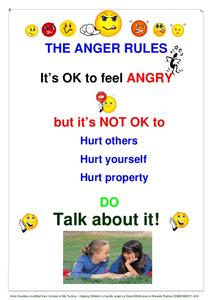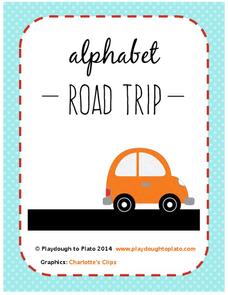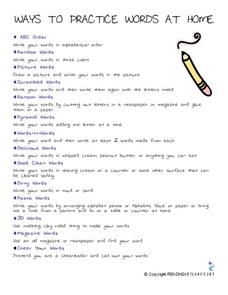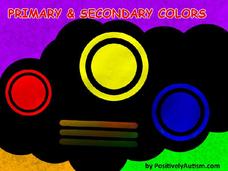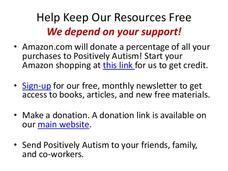PBIS World
Antecedent Behavior Consequence Log (ABC Chart)
To get a full view of a pupil's behavior, examine what happened before and after the behavior. This chart provides a way to organize your observations and track the before, during, and after of target behaviors.
Do2Learn
Behavior Management Plan
Gather all the information needed for a behavior management plan in one place. Establish goals, target replacement behaviors, get student feedback, and identify methods that will be used to monitor behavior. There's even a place to log...
Flourish N Thrive Counseling
A Volcano in My Tummy (Helping Children to Handle Anger)
Sometimes it's hard for kids to express their anger appropriately, or to understand what is happening to their bodies when they feel angry. An insightful lesson about anger management can help them identify angry feelings. It includes a...
PBIS World
Efficient Functional Behavior Assessment Checklist
Work on a learner's problem behavior in your classroom with a behavior assessment checklist. After identifying the behavior, educators can indicate how often the behavior occurs, any events that could cause or encourage the...
PBIS World
Parent Questionnaire
Parents are an invaluable asset when it comes to getting to know the kids in your class. Ask them to fill out a short worksheet with questions about their children, including their strengths and weaknesses, how their child handles...
PBIS World
Time Out Log
Manage your classroom with a log for recording time outs. With spaces for antecedents to the behavior, desired behavior, student's reaction, and the time in and out, the log can be an important tool in a learner's behavior management plan.
Elaine Whithouse & Warwick Pudney
The Anger Rules
What's a healthy way to express your anger? A classroom poster informs kids that feeling angry is all right, but hurting others, yourself, or property is not.
Play Dough to Plato
Alphabet Road Trip
Kids journey through the alphabet by tracing the traffic lines on letter cards.
Briarwood Presbyterian Church
Phonics Lesson Planning Guide
So much to teach, so little time. Keep track of phonics instruction with a guide that permits you to plan phonics lessons addressing 12 difference concepts, in four strands, in the handwriting, maintenance, instruction, and...
PreKinders
Pre-K Assessment Forms
This is a Pre-K teacher's must-have resource for pre-assessing learners at the beginning of the school year! Covering everything from alphabet recognition and sorting objects to social-emotional development and work habits, this...
Reading Resource
Words I Can Read
Help your learners take pride in their reading with a packet of words. Each page has a letter of the alphabet in the upper corner, and plenty of room for kids to jot down the corresponding words that they can now read.
Reading Resource
Ways to Practice Words at Home
Looking for more ways to practice writing words? A list of 27 strategies will engage learners of any level. Kids can choose between writing their words in peanut butter, criss-crossing them with words that share common letters, and...
Reading Resource
Bubble Letters
A fun way to display the alphabet in your classroom! Each letter of the alphabet is featured on a full-page piece of paper, ready for decoration or use as a learning tool.
Reading Resource
Letters in My Name/Friend's Name
After kids learn how to write their names, have them explore each letter with a fun worksheet. They write the letters in their names in the left column, then decipher which letters in the alphabet are not in their name. The second page...
PBIS World
Weekly Scatter Plot
This editable weekly scatter plot, used to document the time and the frequency of particular behaviors, has room to track five behaviors and the interventions intended for each
PBIS World
Confidential Parent Questionnaire
Here's a form that permits student assistance teams to gather information from parents and/or guardians about a child referred to them.
Positively Autism
Primary and Secondary Colors
Red, yellow, blue. Orange, purple, green. Introduce kids to primary and secondary colors with a series of videos and a 19-slide presentation that shows how mixing primary colors produces secondary colors.
Positively Autism
Primary and Secondary Color Worksheets
Here's a worksheet formulated for fun. Kids add two primary colors to produce a secondary color and record the results on train-themed worksheet.
Social Skills Central
Photo Cartoons: Being Polite
Have you ever been left out of plans your friends were discussing? This photo cartoon will help your learners recognize that being polite can go beyond just saying please and thank you by making sure others feel included and...
Positively Autism
"When Mom is on the Phone" Social Skills Story
How should youngsters act when their parents are on the phone? Using the story slides in this resource, your learners will discover the importance of not interrupting a parent's phone call and how to whisper or play with toys quietly.
Positively Autism
"Share the Road" Folder/Shoebox Games
Introduce the importance of sharing and taking turns with your learners through a hands-on learning experience involving toy cars! Here you'll find activity instructions and printables to support your "Share the Road" collaborative...
Positively Autism
"Saying "Hello" to People" Social Skills Story
Support learners who may be very shy or reserved in saying "hello" to new people with this set of story slides. The presentation begins with a few slides describing why it is good to greet others, and concludes with opportunities to...
Positively Autism
"Other People Can Be First" Social Skills Story
Remind learners that sometimes other people might like to be first to answer questions, drink from the water fountain, get to the classroom, and other common daily events. This resource includes nine story slides of visuals and simple...
Positively Autism
"Saying 'No, Thank You'" Social Skills Story
Teach learners to use polite words when they do not want something, rather than being rude or aggressive, using these simple presentation slides. The presentation walks students step by step through what it means to say "No,...






